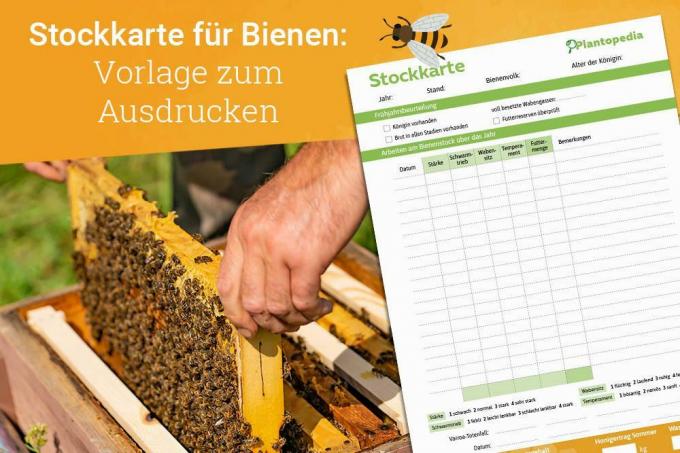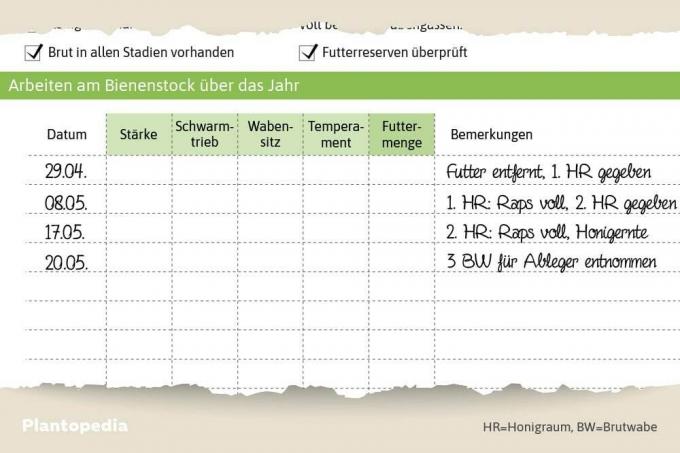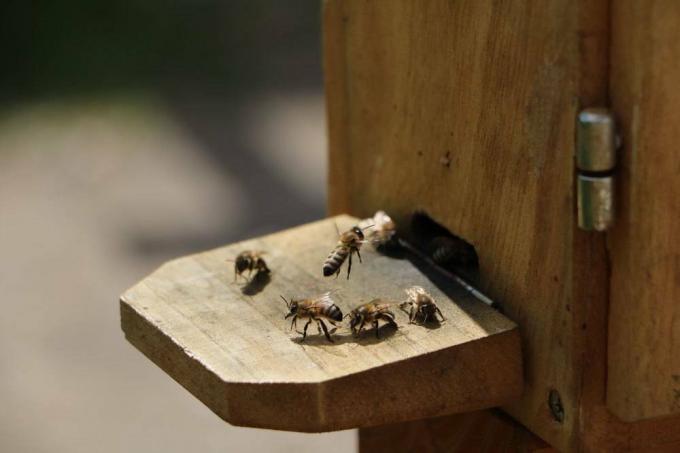
table of contents
- Stock card for beekeepers
- Head of the stock card
- Spring assessment
- Beekeeping in the bee year
- Simple population multiplication
- Varroa in view
- Best honey quality
- Evaluate findings
The successful keeping of bee colonies is one of the most beautiful things a home garden can offer. Beginners as well as experienced beekeepers should always keep an eye on their bees - ideally with our stock card.
Stock card for beekeepers
Regardless of whether you are a hobby beekeeper or a professional - if you want to keep an eye on your bee colony, there is more than just one for you bee-friendly garden important. A stock card is also essential. Because in this way everything can be documented that has been discovered or carried out on the bees. For a simple and tidy overview, you will find the template for a stock map to download as a PDF here.

You can download the stock map for free here:

Head of the stock card
The following data is initially recorded in the head of the Plantopedia stock card:
- the current year,
- the location of the people,
- the number or more precise description of the bee colony and
- the age of the queen.
The location can of course be omitted if all bees are at the same stand. That age the beekeeper recognizes the queen by the Color of the mark (a 2019 queen was marked green). If available, the number of the queen can also be noted (for example "green 1").
Spring assessment
Major interventions in the colony can still be avoided in March, but the beekeeper should definitely use the first nicer days (temperatures above 12 ° C and sunshine). Capture here how your people are positioned.
- Did the queen survive the winter?
- How strong are the people? - Count the number of occupied honeycomb lanes.
- Can you spot brood in all stages (pens, larvae and capped cells)?
- It is also essential to check whether the colony still has enough food reserves, there may still be a cold snap.
tip: If you find brood in all stages and enough food, finish the inspection quickly. Where there is brood there is definitely a queen!
Beekeeping in the bee year
If the temperatures are stable from mid / end of April, work with the bees and the Plantopedia stock card can really begin. For the documentation of the current year it is necessary to record every work done on the people. To do this, enter the date and the work carried out under Comments.
These entries should include, for example:
- Removal and addition of honeycombs and bees
- Carrying out treatment against varroosis
- Disease symptoms (Attention: If you suspect the malicious American foulbrood (AFB), inform your responsible veterinary office immediately!)
- Queen seen / queenlessness
- Broken swarm cells
Write down everything here that seems unusual or new to you, or that you think is particularly important.

When it comes to winter supply for your colonies, it is best to weigh them with luggage scales. Enter the calculated amount of feed (consider the weight of bees and hive materials) in the column provided.
Simple population multiplication
As a beekeeper, you should always bring up your best colonies. With our evaluation system you can collect data on your bees over the entire bee year so that you can then select the best ones for breeding in the next year. These parameters are entered in the middle of the table in the form of numbers. At the end of the year you form the mean of the individual categories strength, Swarm instinct, Honeycomb seat and temperament. A legend can be found directly below the table. Perform the assessment regularly, but at least four times per year through:
- Immediately after wintering
- During a mass costume (e.g. rape blossom)
- In the time between varroa treatment and feeding for the winter
- In October, when the bees have already been fed
tip: As a quick indicator of the temperament of the people, you can take the following test. Open the people and tap the top girders of the frames in the box with your fingers. Particularly meek people only hum briefly, but never fly towards you.
Varroa in view
In the lower part of the stock map you should regularly use the Death the Varroa mites document. It is important to actively track the size of the mite population so that you can respond appropriately at the right time. Should you have symptoms of a Varroa damage like discovering crippled wings, shortened abdomen or severely trembling bees (paralysis virus), act as quickly as possible. Then enter how you treat your bees in the table above.
Best honey quality
As a beekeeper, you ensure that natural, high-quality food is produced and placed on the market. One of the most important quality criteria for German bee honey is that Water content. One week before the honey harvest, measure the water content in several places in the honey room with one Refractometer.
In any case, you as a beekeeper are bound by the Honey Ordinance (HonigV). This generally defines a maximum water content of 20%, for heather honeys 23% is the upper limit. The German Beekeeping Association (DIB) takes a somewhat stricter view (general: 18%, heather honey: 21.4%). If the entire honey of the colonies is within the limit values, calculate the mean value from the individual measurements and enter it in the lowest part of the stock map. The amount of honey harvested is also recorded here and can be used as a criterion for propagation.
Evaluate findings
Use the stock card every year and collect the results on your peoples. This not only improves your beekeeping skills over the years, but you can also assess:
- Do the peoples improve through a selection of the best?
- How is the local costume offering changing?
- How is the overall apiary developing?




